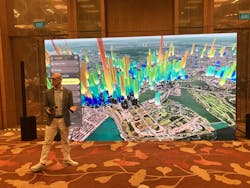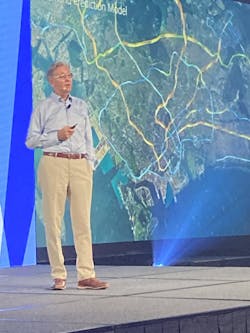Bentley fills engineering resource gaps with infrastructure smarts
Just like knives, plows, steam engines, airplanes and transistors, software and its digitalized tools are labor-saving devices. They allow fewer people to do more work, but also let rookie workers do more when fewer knowledgeable veterans are available. Filling these yawning engineering gaps with “infrastructure intelligence” built on focused data, digital twins and artificial intelligence (AI) was the main theme of Bentley Systems Inc.’s recent Year in Infrastructure (YII) 2023 event on Oct. 11-12 in Singapore.
The conference was attended by more than 325 visitors, who took in training sessions, technical demonstrations and exhibits about Bentley’s iTwin platform and Infrastructure Cloud solutions, including ProjectWise for project delivery, Synchro for construction, and AssetWise for asset operations. These software packages can be aligned, queried, and managed to increase infrastructure intelligence over the lifecycle of projects and assets. These capabilities were amply demonstrated by the 12 winners of Bentley’s 2023 Going Digital Awards announced at the event.
“We’re facing an engineering resource capacity gap, and going digital is the only answer,” said Greg Bentley, CEO of Bentley, during his keynote address kicking off YII 2023. “We asked our finalists to quantify the engineering hours that digitalization can save, and their average estimate was 18%. We’re also talking about generative artificial intelligence (AI), and all the unrealized value we can get from data we couldn’t access before and situations we couldn’t previously anticipate, such as infrastructure intelligence from OT, IT and enterprise technology (ET) levels.”
Kaushik Chakraborty, SVP for Southeast Asia and India at Bentley, added, “We’re also seeing larger and more complex projects in our region, and they need more integrated approaches, especially during the design phase. This is where digitalization can help.”
Nicholas Cumins, COO at Bentley, explained, “There’s a shortage of infrastructure engineers because so many are retiring and there aren’t enough new graduates. Many skills are also changing, so it’s crucial to leverage digital twins to develop greater infrastructure intelligence, which is founded on data, and can use a greater breadth and depth of it to improve project deliver and asset performance. This includes integrating data from other disciplines, such as the enterprise and supply chains.”
For instance, Henry Okraglik, global digital director at engineering services provider WSP Australia, reported at YII 2023 on the benefits of using Bentley Infrastructure Cloud to become more data-centric. By using ProjectWise, Synchro, iTwin, and other Bentley products, WSP reports it reduced modeling time by 60%, increased productivity by 25%, and reduce its carbon footprint by 30% on a rail network project in Melbourne.
“As we digitally matured, we embraced capabilities from Bentley Infrastructure Cloud to improve construction staging and planning, track and export quantity data across project phases, and reduce the need for physical site visits,” said Okraglik.
Singapore leads intelligence efforts
Bentley reported that YII 2023 host Singapore is way ahead on confronting and solving many engineering resource gap challenges, and uses Bentley’s software and digital twins to optimize decision-making and operations in many infrastructure applications, which is confirmed by its high ratio of Going Digital Award-winning projects. These projects include:
- Singapore’s national water agency, PUB, is collaborating with Bentley on a project funded by the Singapore National Research Foundation to develop a new system for detecting and localizing water system anomalies and leaks in near real-time. By using a high-fidelity digital twin, AI-based predictive models, and hydraulic network model calibration and simulation, the project could improve network resilience and water conservation.
- SMRT Trains, Singapore’s multi-modal, public-transport operator, uses Bentley’s AssetWise Linear Analytics software for its predictive, decision-support system to prioritize maintenance. This digital twin system lets SMRT meet its service-reliability targets by optimizing maintenance deployments.
- Singapore’s Land Transport Authority (LTA) uses Bentley’s EMME and Dynameq mobility-digital-twin software for long- and short-term planning, such as creating operational traffic models for traffic impact and scheme analysis. This includes using Bentley’s agent-based travel demand model.
- Singapore Land Authority (SLA) used aerial surveying and digital 3D maps to develop a nationwide, virtual-reality mesh accurate to 0.225 meters. Dr. Victor Khoo, survey and geomatics director at SLA, reported this mesh includes inputs from other mapping datasets to produce a complete digital twin of the city, which is shared with multiple agencies and research institutes to support Singapore’s sustainability initiatives.
Award winners announced
YII 2023 was also highlighted by the announcement of the 12 winners of the 2023 Going Digital Awards. Twelve independent jury panel determined the winners in a dozen categories from 36 finalists, which were shortlisted from more than 300 nominations submitted by 235 organizations from 51 countries. The winners in each category are:
- Bridges and tunnels—SP Australia Pty., Ltd.—Southern program alliance for Melbourne, Victoria, Australia
- Construction—Laing O’Rourke—SEPA Surrey Hills level crossing removal project in Melbourne, Victoria, Australia
- Enterprise engineering—Mott MacDonald—Standardizing delivery of phosphorus removal schemes for the U.K. water industry in the U.K.
- Facilities, campuses and cities—vrame Consult GmbH—Siemensstadt Square, a digital campus twin in Berlin, Germany
- Process and power generation—Shenyang Aluminum & Magnesium Engineering & Research Institute Co., Ltd.—Digital twin application project of electrolytic aluminum engineering of Chinalco China Resources in Lvliang, Shanxi, China
- Rail and transit—Aecom Perunding Sdn. Bhd.—Johor Bahru–Singapore rapid transit system link in Malaysia and Singapore
- Roads and highway—Atkins—I-70 Floyd Hill to Veterans Memorial tunnels project, in Idaho Springs, Colo.
- Structural engineering—Hyundai Engineering—Automated design of civil and architectural structures with Staad API in Seoul, South Korea
- Subsurface modeling and analysis—Arcadis—South Dock Bridge in London, U.K.
- Surveying and monitoring—Italferr S.p.A.—The digital twin for structural monitoring of St. Peter’s Basilica, Vatican City
- Transmission and distribution—PowerChina Hubei Electric Engineering Co., Ltd.—Full lifecycle digital application on Xianning Chibi 500kV substation project in Xianning, Hubei, China
- Water and wastewater—Project Controls Cubed LLC—EchoWater project in Sacramento, Calif.


